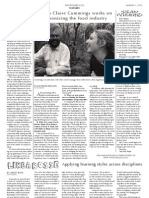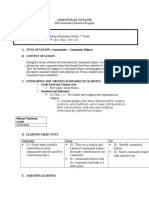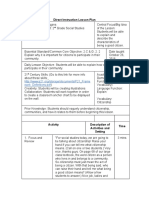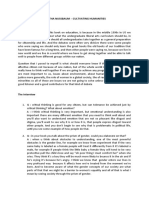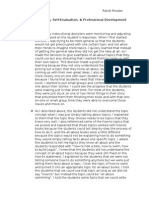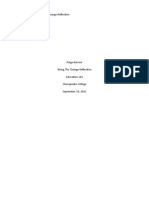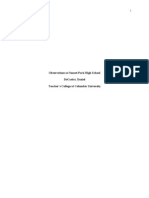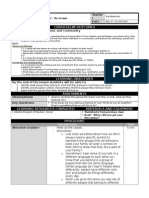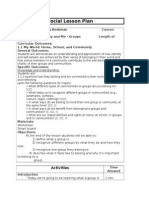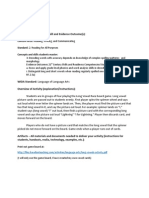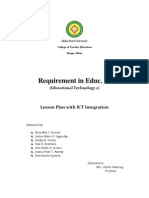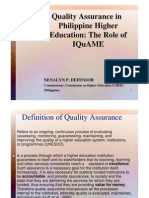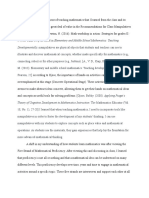Community Lesson Plan1
Community Lesson Plan1
Uploaded by
api-251645446Copyright:
Available Formats
Community Lesson Plan1
Community Lesson Plan1
Uploaded by
api-251645446Original Title
Copyright
Available Formats
Share this document
Did you find this document useful?
Is this content inappropriate?
Copyright:
Available Formats
Community Lesson Plan1
Community Lesson Plan1
Uploaded by
api-251645446Copyright:
Available Formats
Immersion I Lesson Plan Format Field Study Teacher: Jule Peterson Grade Level: 2nd Unit: Civics Lesson
School: Park Elementary Number of Students in Class: 17 Duration: 1 Hour
Day, Date, and Time of Lesson: 4/8 at 8:10 AM 9:10 1. Objective(s): By the end of the lesson, students will be able to describe characteristics that create a responsible community member.
2. Colorado Academic Standards: Content area: Social Studies Standard: 4. Civics Concepts and skills students master: 1. Responsible community members advocate for their ideas evidence outcomes: a. Describe important characteristics of a responsible community member (DOK 1-2)
3. Learning Target(s): I can identify important characteristics that create a responsible community member.
4. Assessment: Teacher will collect their persuasive writings about when they have shown courage or another trait in a community they are a part of. Assess how well they related a moral or characteristic to community well-being.
5. Materials: The book, Balto and the Great Race and students writing journals.
6. Introduction/Anticipatory Set: I will begin the lesson by tapping into students schema and asking what they know about the Iditarod. Where is it located? (allow wait time) "What is the culture where it is located? (allow wait time)
What is the history behind the Iditarod? (allow wait time) What is a community? 7. Essential Questions or Big Picture Statement: How can we be responsible community members and respect every culture? 8. ****Step-by-Step Lesson Process:**** 1) Begin lesson with anticipatory set. 4 minutes 2) Tell students more about the culture that they did not touch on. Explain that this particular culture did not have the transportation or technology we have today, but this does not make them less than us. Emphasize the importance of unity within a community and that, without it, this culture may not have survived. Lastly, explain that we are going to read a story about a dog who had an important characteristic that allowed him to help his community. 5 minutes 3) Begin reading book, Balto and the Great Race whenever the id ea of courage comes up, talk to students about it. Relate Baltos courage to an important characteristic of a responsible community member. Use think aloud method. 20 minutes 4) After reading the book, ask students about how Balto helped his community (check for understanding). First, ask them what community means again. Then, ask what a characteristic is. Next ask, What characteristic allowed him to help his community? What are other important characteristics to have in a successful community? 5 minutes 5) Direct instruction: After discussion about courage and how it helped the community, tell students to begin a reading response about a time they have helped their community (independent practice). If they cannot think of a specific moment, ask them to write why it is important to be a responsible community member/what traits create a responsible community member. (Check if they understand the assignment by asking for a thumbs up or down). Write prompts on board for students to refer back to. 25 mintues a. Model for students an example of what you may write, I might write about when I was your age and planted a community garden that the entire town could use, this was a way that I helped my community. Reiterate that a community can be their classroom, school, organization, or Durango. 1 minutes 6) For closure, ask students to share their writing with the class. If there is additional time remaining ask how they can be a responsible community member today. Call on anyone raising their hand.
Jule Peterson
Evaluation of the Community Lesson When I did my community lesson plan, I felt like many things went really well. For one, we had some really great discussions. Before I read them the story, Balto and the Great Race, I asked them some questions to understand what their background knowledge was about what a community is. I asked what the word community meant and they answered correctly. We got into a discussion of different types of communities, and then talked about what makes us good community members. The students brainstormed ways that a community works together, which made me feel like we had a meaningful discussion. This part of my lesson went a lot better than I imagined, and it was a great discussion to have before the book because students could listen and make connections to Balto and his community. The second thing that went really well was reading the book. I was unsure if the book I picked out was going to be boring for them; however, after I finished reading some students yelled out, read it again!that was a reassuring moment. Lastly, I felt like the activity following the story went well because they all enjoyed making their own connections. I wanted them to write about how they have been helpful in their own community, which could be their class, school, Durango, neighborhood, or another group they are a part of. I was fearful that students would not understand the community aspect and just write about a time they did something good, but to my surprise, every single one of them connected their story to a community. I thought this was the best part of the lesson, because I could see whether they really understood what a community was, and characteristics of a good community member. From my impression, the objective was met because they all responded with meaningful, relevant stories.
Not everything went as smoothly as I hoped. Of course, like many of my lesson plans, time management was a little rough. Thankfully, we managed to get through mostly the whole lesson. Some students were not able to finish their reading response, and we did not get to the closure part of the lesson where students could share their responses with the class. I do not think this was avoidable on my part, because my CT gave me about 30 to 45 minutes to do the lesson, when I was hoping for one hour. However, given the shortage of time, I felt like the lesson still went smoothly and I did not have to rush through the reading or discussions. Other than time management, I felt like the rest of the lesson went well, and, as I mentioned before, the objective was definitely met. My objective was that, students will be able to describe characteristics that create a responsible community member. They met this goal when we were having a discussion before the reading, and after the reading when I asked how Balto helped his community. I could also see that the entire class understood the objective when they did their reading response. Their responses were all a characteristic of a responsible community member, and they all knew a community was their class, school, Durango, or other another group they are a part of. I would like to do a follow-up lesson of some sort to see if they still remember what communities are and examples of how to be a responsible community member. Although, from my formative assessment during their reading response, I feel like they all understood what it means to be a responsible community member. If I were to do a follow-up lesson, I would read another book about community and/or a characteristic of a good community member, and then at the end of the book ask them what the book was about that we recently studied. I would try and see if they could pull the concept out of the book on their own, or if they would need guided support
in doing this. Ideally, if they all truly understood the idea of community and community members, they would be able to recognize it in a book that is all about that concept. As far as culturally responsive pedagogy, I believe I paid attention to this aspect, but it was not my main focus. Looking back now, I believe I was more culturally responsive than not. The story of Balto is definitely one that I can relate to more than these students and it is more a part of my culture, so I tried to connect the idea of Baltos story to things they would relate to better. My teacher helped me explain that the distance traveled was as if someone biked from here to Montana. This helped put the distance more into perspective. I was also aware that some students may not know certain words in the book, so I would define the word as I read it, or ask students what it meant. Most students in my classroom are all at about the same place academically, culturally, and economically, so being extra culturally responsive is not always necessary. I felt like this lesson did not require for me to adjust my pedagogy very much either, because everyone understood the lesson and what was being taught. If I were to do the lesson again in the future, I am sure I would do a lot differently. Perhaps, I would try to find a story that was a little more challenging to read, to give the more advanced readers some differentiation, and then have everyone read silently alone, instead of me reading to them. I really liked our discussions before and after, so that would remain the same. I would also consider, if I had more time, having them do a more intricate activity after reading Balto. They could create a poster, cut out pictures, and explain what a responsible community member looks like to them. In general, if I did this lesson again I would focus on expanding it into a more in-depth project. The students had a lot to say about communities and their part in a community, and I would have loved to hear their responses. I thought a great
way for them to incorporate their new writing skills they are learning would be to have them create their own fictional story about a character who helps a community. This would allow them to put their background knowledge into a more creative, fun writing piece. This lesson was one that I could definitely see myself doing in the future. I was happily surprised at the amount of input that the students had to offer during our discussions. Even though they all seemed to have an idea of what a responsible community member looks like, by the end I could tell they had an even deeper understanding. This lesson may not have went as I initially expected, but nonetheless, it was successful and a great learning experience for myself.
You might also like
- Schooltalk: Rethinking What We Say Aboutand ToStudents Every DayFrom EverandSchooltalk: Rethinking What We Say Aboutand ToStudents Every DayRating: 5 out of 5 stars5/5 (1)
- English 7 4th Quarter Week 5 Detailed Lesson PlanDocument6 pagesEnglish 7 4th Quarter Week 5 Detailed Lesson PlanKoy Poblete50% (2)
- Nerdy BirdyDocument4 pagesNerdy Birdyapi-314784763100% (1)
- Cultural Identity Who Am I Lesson PlanDocument4 pagesCultural Identity Who Am I Lesson Planapi-316502259100% (2)
- 8.features.3 1Document1 page8.features.3 1lindsey_arynNo ratings yet
- Social Citizenship Lesson PlanDocument3 pagesSocial Citizenship Lesson Planapi-426565990No ratings yet
- Community Lesson PlanDocument2 pagesCommunity Lesson Planapi-251645446No ratings yet
- Social Studies Lesson 1Document8 pagesSocial Studies Lesson 1api-302238442No ratings yet
- Communities Day 8Document3 pagesCommunities Day 8api-272178501No ratings yet
- Direct Instruction Lesson Plan: Work - Definitions PDFDocument5 pagesDirect Instruction Lesson Plan: Work - Definitions PDFapi-336817618No ratings yet
- Literacy NarrativeDocument8 pagesLiteracy Narrativeapi-707468268No ratings yet
- ConclusionDocument6 pagesConclusioncoribrooks4No ratings yet
- Communities UnitDocument27 pagesCommunities Unitapi-271289972No ratings yet
- Pedu Lesson Plan 2Document4 pagesPedu Lesson Plan 2api-336636224No ratings yet
- Fieldwork Notebook 6Document3 pagesFieldwork Notebook 6api-233605868No ratings yet
- Marleigha Lossin Matc Synthesis PaperDocument11 pagesMarleigha Lossin Matc Synthesis Paperapi-643390461No ratings yet
- Education 580 Artifact DescriptionDocument5 pagesEducation 580 Artifact Descriptionapi-304529596No ratings yet
- SRE ContextDocument8 pagesSRE Contextapi-285422446No ratings yet
- Peacemakers Application 1Document1 pagePeacemakers Application 1maureenmaherNo ratings yet
- Pen Pals in A Far Away PlaceDocument12 pagesPen Pals in A Far Away Placecoribrooks4No ratings yet
- 12 Blog PostsDocument10 pages12 Blog Postsapi-520627593No ratings yet
- Update Citizen Characteristics-Twt-InitialDocument4 pagesUpdate Citizen Characteristics-Twt-Initialapi-192946704No ratings yet
- Feature Lesson Plan RevisedDocument5 pagesFeature Lesson Plan Revisedapi-317142361No ratings yet
- A Commonplace Book on Teaching and Learning: Reflections on Learning Processes, Teaching Methods, and Their Effects on Scientific LiteracyFrom EverandA Commonplace Book on Teaching and Learning: Reflections on Learning Processes, Teaching Methods, and Their Effects on Scientific LiteracyNo ratings yet
- wk3 IndDocument3 pageswk3 Indapi-510713019No ratings yet
- Reflection 580Document5 pagesReflection 580api-333351868No ratings yet
- While There's Time: Conservatism and Individualism in EducationFrom EverandWhile There's Time: Conservatism and Individualism in EducationNo ratings yet
- Synthesis of ArtifactsDocument9 pagesSynthesis of Artifactsapi-364531747No ratings yet
- Assessment - 1 IntegrityDocument6 pagesAssessment - 1 IntegrityTommy HeriyantoNo ratings yet
- Martha Nussbaum - Cultvating HumanitiesDocument2 pagesMartha Nussbaum - Cultvating Humanitiesnisa asytiyahNo ratings yet
- Literacy NarrativeDocument5 pagesLiteracy Narrativeapi-284604582No ratings yet
- Civics/Literacy Integration Lesson PlanDocument7 pagesCivics/Literacy Integration Lesson Planapi-357033410No ratings yet
- Student Teaching Character Traits Patterns in Character ReactionsDocument4 pagesStudent Teaching Character Traits Patterns in Character Reactionsapi-317063493No ratings yet
- Standard 1Document4 pagesStandard 1api-406139711No ratings yet
- Culminating ActivityDocument17 pagesCulminating ActivityRaven Andrea AtienzaNo ratings yet
- Cinderella Stories - 339Document7 pagesCinderella Stories - 339api-456327655No ratings yet
- Culturally Responsive TeachingDocument7 pagesCulturally Responsive Teachingcbieber267% (3)
- Samb rr1Document6 pagesSamb rr1api-280552667No ratings yet
- Inclusion Includes Us: Building Bridges and Removing Barriers in Early Childhood ClassroomsFrom EverandInclusion Includes Us: Building Bridges and Removing Barriers in Early Childhood ClassroomsNo ratings yet
- Circle Time Literature ReviewDocument6 pagesCircle Time Literature Reviewafmzkbuvlmmhqq100% (1)
- Perspective PaperDocument5 pagesPerspective Paperapi-287623259No ratings yet
- Eced461 tws8 RhodesDocument6 pagesEced461 tws8 Rhodesapi-200991021No ratings yet
- BDA (Communications Component)Document4 pagesBDA (Communications Component)nehemyNo ratings yet
- Being The Change ReflectionDocument6 pagesBeing The Change Reflectionapi-652468450No ratings yet
- Dblanco Hd363documentation Capstone33116Document4 pagesDblanco Hd363documentation Capstone33116api-282907054No ratings yet
- Siop Lesson PlanDocument8 pagesSiop Lesson Planapi-285001478No ratings yet
- Untitleddocument 3Document8 pagesUntitleddocument 3api-339193750No ratings yet
- LessonplanDocument4 pagesLessonplanapi-383585295No ratings yet
- Observations at Sunset Park High School Decastro, Daniel Teacher'S College at Columbia UniversityDocument7 pagesObservations at Sunset Park High School Decastro, Daniel Teacher'S College at Columbia UniversitysarahschlessNo ratings yet
- Social 1-2 Lesson 5 - Nov 17 14Document4 pagesSocial 1-2 Lesson 5 - Nov 17 14api-242345831No ratings yet
- 6th Grade Reading Interest SurveyDocument6 pages6th Grade Reading Interest Surveyapi-385553468No ratings yet
- Discourse Community EthnographyDocument8 pagesDiscourse Community Ethnographyapi-302568798No ratings yet
- Edl 318 Inquiry To Curriculum Part 2Document8 pagesEdl 318 Inquiry To Curriculum Part 2api-253842446No ratings yet
- Direct Instruction Lesson Plan TemplateDocument4 pagesDirect Instruction Lesson Plan Templateapi-282805900No ratings yet
- Standard 2-Course ReflectionDocument3 pagesStandard 2-Course Reflectionapi-728719858No ratings yet
- First They Killed My Father An Introduction To The Novel Lesson PlanDocument5 pagesFirst They Killed My Father An Introduction To The Novel Lesson PlanJacjac BattsNo ratings yet
- Read Aloud ReflectionDocument4 pagesRead Aloud Reflectionapi-298464083No ratings yet
- Rationale TermivDocument9 pagesRationale Termivapi-192946704No ratings yet
- Social Lesson Plan: ActivitiesDocument8 pagesSocial Lesson Plan: Activitiesapi-242345831No ratings yet
- BullyDocument5 pagesBullyapi-251645446No ratings yet
- Ed628 UbdDocument2 pagesEd628 Ubdapi-251645446No ratings yet
- Funds of Knowledge Lesson PlanDocument3 pagesFunds of Knowledge Lesson Planapi-251645446No ratings yet
- Ed628 UbdDocument2 pagesEd628 Ubdapi-251645446No ratings yet
- Cyberbullying InfographicDocument1 pageCyberbullying Infographicapi-251645446No ratings yet
- Emerging Tech ProposalDocument7 pagesEmerging Tech Proposalapi-251645446No ratings yet
- Liz Major, Jon King, Jule PetersonDocument1 pageLiz Major, Jon King, Jule Petersonapi-251645446No ratings yet
- Writing Devel Assign For PortfolioDocument5 pagesWriting Devel Assign For Portfolioapi-251645446No ratings yet
- Lessonplan 1Document3 pagesLessonplan 1api-251645446No ratings yet
- Oral Language Development ActivityDocument3 pagesOral Language Development Activityapi-251645446No ratings yet
- Curriculum Vitae Mutiara ShabrinaDocument3 pagesCurriculum Vitae Mutiara ShabrinaDeny HermawanNo ratings yet
- Why Do Students Misbehave?: School and LearningDocument7 pagesWhy Do Students Misbehave?: School and LearningGenelyn GerafuscoNo ratings yet
- Application Form - EnggDocument5 pagesApplication Form - EnggVijaya KanakalaNo ratings yet
- LP Mam TambongDocument9 pagesLP Mam TambongGladys Degones GuillerNo ratings yet
- Lesson Plan - How To Make Chocolate Chip CookiesDocument7 pagesLesson Plan - How To Make Chocolate Chip Cookiesapi-399468103No ratings yet
- Kelsey Clovechok ResumeDocument3 pagesKelsey Clovechok Resumeapi-252339195No ratings yet
- The Significance of Learners¡ ErrorsDocument19 pagesThe Significance of Learners¡ ErrorsAline BehlingNo ratings yet
- IquameDocument16 pagesIquameJose Paolo Espina100% (1)
- Ped 10Document12 pagesPed 10quennie ira cacholaNo ratings yet
- Syllabus Case Studies in Corporate FinanceDocument6 pagesSyllabus Case Studies in Corporate FinanceFahima_lmNo ratings yet
- Edu 625 Project 1 PaperDocument4 pagesEdu 625 Project 1 Paperapi-291985635No ratings yet
- No Homework Policy BillDocument13 pagesNo Homework Policy BillKyla A. Gloria100% (2)
- Field 3 Narrative Partner TeacherDocument2 pagesField 3 Narrative Partner Teacherapi-281269862No ratings yet
- Concept PaperDocument2 pagesConcept PaperClarisse Tingchuy0% (1)
- Dogs Trust - Basic Dog TrainingDocument5 pagesDogs Trust - Basic Dog TrainingSanja Garro AtilaNo ratings yet
- Jolly Phonics PresentationDocument37 pagesJolly Phonics Presentationidelamata100% (3)
- 118 Katz enDocument9 pages118 Katz endileep_audichyaNo ratings yet
- Proforma Mte 3102 - Mathematics Education CurriculumDocument3 pagesProforma Mte 3102 - Mathematics Education CurriculumMUHAMMAD RIDHUAN BIN HANAFINo ratings yet
- Finland PhenomenonDocument2 pagesFinland PhenomenonKatherine DahangNo ratings yet
- Welcome To D'auvergne School: Information BookletDocument12 pagesWelcome To D'auvergne School: Information BookletEunice RodriguesNo ratings yet
- 1-10 Summative Test (Transversal Competencies)Document2 pages1-10 Summative Test (Transversal Competencies)Ryan GerasmioNo ratings yet
- 299 Yearbook EngDocument36 pages299 Yearbook Engrossminy2No ratings yet
- Assure Model RPHDocument3 pagesAssure Model RPHChenChenNo ratings yet
- Tle CookeryDocument3 pagesTle CookeryMikhaila Fernandez100% (3)
- Sight Word LessonDocument9 pagesSight Word Lessonapi-273012643No ratings yet
- Rubrics EvaluationDocument3 pagesRubrics EvaluationMark KevinNo ratings yet
- Amanda NicklessDocument9 pagesAmanda Nicklessapi-309656697No ratings yet
- Tornado Revised Lesson PlanDocument5 pagesTornado Revised Lesson Planapi-337392204No ratings yet
- Journal Reflection FinalDocument4 pagesJournal Reflection Finalapi-350123955No ratings yet




